Though overvalued, Belgium's housing market is heading up
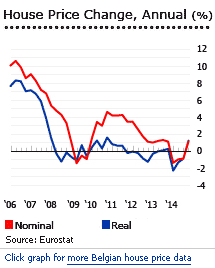
Property prices in Belgium are rising again, after a short-lived decline in the first half of 2014. Nationwide, Belgian house prices rose by 1.13% (1.23% inflation-adjusted) y-o-y in 2014, based on Statistics Belgium figures. On a quarterly basis, house prices increased 1% (1.1% inflation-adjusted) in Q4 2014.
During 2014:
- House prices rose by 2.42% (2.51% inflation-adjusted), after increases of 0.06% in 2013, 1.1% in 2012, 3.31% in 2011 and 5.05% in 2010.
- Apartment prices increased slightly by 0.52% (0.62% inflation-adjusted) y-o-y, after a fall of 0.59% in 2013 and rises of 2.62% in 2012, 4.62% in 2011 and 5.43% in 2010
- Villa prices rose by 1.82% (1.92% inflation-adjusted), an improvement from a decline of 1.03% in 2013, and a meagre increase of 0.25% in 2012
The purchase price of existing dwellings rose by 1.7% (1.8% inflation-adjusted) in 2014 from a year earlier. On the other hand, the price of new dwellings fell by 0.6% (-0.5% inflation-adjusted). The average price of regular houses in Belgium stood at €202,137 in the third quarter of last year:
- In Brussels-Capital region, house prices fell by 1.33% (-1.33% inflation-adjusted) to an average of €370,131
- In the Flemish region (Flanders), house prices increased slightly by 0.15% (0.15% inflation-adjusted) to an average of €215,053
- In the Walloon region (Wallonia), house prices rose by 1.57% (1.57% inflation-adjusted) to an average of €153,082
During Belgium’s housing boom (2000-Q3 2008), nationwide house prices soared by 129% (86% inflation-adjusted).
Since the crisis, Belgian house prices have followed the economy. In years when the economy was strong, house-prices rose. When the economy was weak, house prices stagnated. The Belgian economy expanded by 1% in 2014, the strongest growth since its 1.8% expansion in 2011, mainly due to growth in the industrial and construction sectors. The economy is projected to grow by 1.25% and 1.5% in 2015 and 2016, respectively, according to Rabobank Group.
Regional house price variations
Belgium is divided into three regions:
- the Flemish Region occupies the north, with Dutch-speaking communities;
- the Walloon Region is in the south, and is made-up largely of French-speaking communities with a small German-speaking community in the south-east; and
- Brussels, the administrative capital region, an officially tri-lingual city inside the Flemish region.
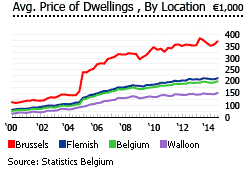
Each region and community has a separate parliament and executive administration. Power has been increasingly devolved. There is also a persisting ethnic conflict, and the political union has come under rising threat.
Property prices in Belgium’s three regions move in the same price cycle, but the capital has experienced much the highest price increases. Prices in Brussels surged almost 200% (140% in real terms) from 1998 to 2008, much more than in the two other regions (143% for the Flemish region and 116% in Wallonia), according to Statistics Belgium.
Prices also fell most in Brussels during 2010, though the falls were relatively insignificant. The average price of ordinary houses in Brussels decreased 1.44% (4.27% inflation-adjusted) in 2010; while house prices continued to rise by 4.59% in the Flemish region and by 4.18% in the Walloon region.
The drivers of Belgium’s house price boom were:
- rapid mortgage market expansion due to low interest rates and increased competition between banks; and
- relatively strong economic and wage growth.
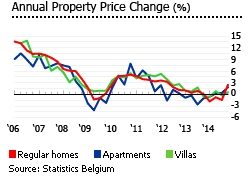
When these conditions were reversed with the global credit crunch, house prices stopped rising. Then when the economy emerged from recession in 2011, the housing market bounced back strongly with Brussels house prices surging by 9.58% (5.7% inflation-adjusted). House prices in the country as a whole rose modestly by 2.59% in 2012 and by another 1.87% in 2013.
Is Belgian housing overvalued? Probably yes.
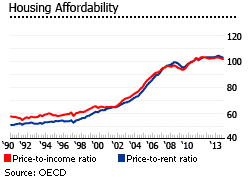
There is general agreement that the housing market slowdown in the first half of 2014 was not enough to bring house prices back to "normal" levels. That begs the question, what is normal?
There are many different opinions, but research generally suggests that Belgian house prices are overvalued. One view is that of the Belgian Federal Institute of National Accounts, which suggests that Belgian house prices are overvalued by only about 9%. However research by the Organisation for Economic Co-operation and Development (OECD) has suggested that Belgium’s housing market is overvalued by as much as 50%, because income has not risen as quickly as house prices. Deutsche Bank agrees that Belgian homes remain 53% overvalued, with house prices still 51% higher than the historical average, relative to income. And the International Monetary Fund (IMF) also warned in 2014 that house prices in Belgium remain well above historical averages in relation to incomes and rents.
More houses are being built
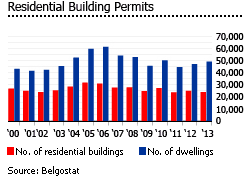
During the first eleven months of 2014, dwelling permits rose 13.8% to 50,350 units from the same period last year, and residential building permits rose by 10.1%.
Dwelling permits and dwelling starts dropped during the crisis from 2007 to 2009, with only 41,508 dwellings started in 2009, compared to an average of 55,400 units from 2005 to 2007. Dwelling permits also fell to around 45,000 units in 2009, lower than 58,000 permit annual average from 2005 to 2007.
In 2010, residential construction recovered, with residential building permits and dwelling permits rising by 10.5% and 9.7%, respectively. In 2013, dwellings permits rose modestly by 4.7%, to about 49,000 units, after a rise of 5.5% in 2012, and a decline of 11.1% in 2011.
But housing demand is waning

In the first three quarters of 2014, the total number of dwellings sold fell by 6.2% to less than 85,000 units from the same period last year. Apartments and flats saw the biggest decline, with the number of transactions for regular houses falling by 5.7% y-o-y during the first three quarters of 2014, followed by regular houses (-5.7%) and villas and bungalows (-5.1%). Transactions for building plots also declined 6.2% over the same period.
Mortgage interest rates are at record lows
In January 2015, the following average housing loan rates applied in Belgium:
- Floating rate and with IRF of up to 1 year: 2.75%, down from 3.09% a year earlier
- IRF over 1 and up to 5 years: 2.43%, down from 3.19% a year earlier
- IRF over 5 years and up to 10 years: 2.72%, down from 3.7% a year earlier
- IRF over 10 years: 2.76%, down from 3.82% a year ago
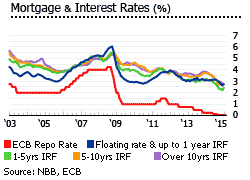
Interest rates had peaked at 5.33% in October 2008 for new mortgages with 10-year interest rate fixation (IRF), while those with floating rate and up to 1year IRF peaked at 6.02%.
Mortgage market is expanding rapidly
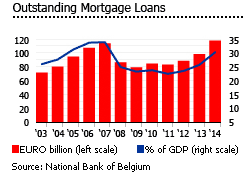
Outstanding housing loans surged by 20% y-o-y to €117.8 billion in 2014, after annual increases of 11.2% in 2013 and 6.5% in 2012, based on figures from the European Central Bank (ECB).
After growing to about 34% of GDP by 2007, Belgium’s mortgage market contracted to just 22.5% of GDP in 2011, due to the crisis. However a sharp reversal has been seen over the past three years and housing loan volumes have soared again. In 2014, the size of the mortgage market was again more than 30% of GDP.
The Belgian mortgage market has been dominated by four major private financial institutions: Fortis, Dexia, KBC, and ING Belgium since a wave of privatization, mergers and acquisition in the 1990s. All four have interests spread across the financial industry including investment management, retail banking and insurance. Intense competition has led to low fees and charges, and more mortgage options.
Moderate rental yields, subdued rental market,
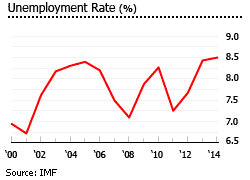
Gross rental yields have fallen sharply in recent years, according to Global Property Guide research. Gross rental on apartments in Brussels range from around 4.56% to 5.53%, while yields on houses range from 4.46% to 5.01%. Meanwhile, the difference between the yields on small properties, which tends to be higher, and those on larger properties, has shrunk.
The rental market has been subdued for a number of years because of rent controls (see Landlord and Tenant section) and the rising number of homeowners. The rental market is significant, at about 30% of the housing stock (23% in the private sector, 7% in social housing); but this is falling, and is down from 38% in 1980 and 33% in 1990. However, 60% of households in Brussels are renters, a fact partly encouraged by Belgium’s unusually high buy/sell costs.
Belgian economy gradually recovering
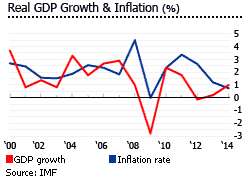
Belgium’s economy grew by 1% from in 2014, according to the National Bank of Belgium (NBB), the strongest figure since its 1.8% expansion in 2011, mainly due to growth in the industrial and construction sectors.
The economy is projected to grow by 1.25% and 1.5% in 2015 and 2016, respectively, according to Rabobank Group.
From 1997 to 2007, the country enjoyed a healthy economic growth of about 2.4% per year. But since the crisis growth has been weak. GDP growth was 0.99% in 2008, -2.8% in 2009, 2.3% in 2010, 1.8% in 2011, - 0.14% in 2012, and 0.2% in 2013, mainly due to the adverse impact of the eurozone debt crisis, according to Belgostat.

In 2014, the country’s seasonally adjusted unemployment rate stood at 8.5%, according to the NBB. The jobless rate for men was 8.9% in January 2015 while it was 8.1% for women.
Falling inflation remains a concern, as elsewhere in the eurozone. In February 2015, Belgium’s inflation rate was -0.4%, based on figures from the NBB. The country had an average annual inflation rate of 2% from 2010 to 2014, according to the IMF.
In 2014, the country’s budget deficit was estimated at about - 3.3% of GDP, according to the National Bank of Belgium. Belgium’s gross national debt amounted to 102% of GDP in 2014, the highest level since 2002.